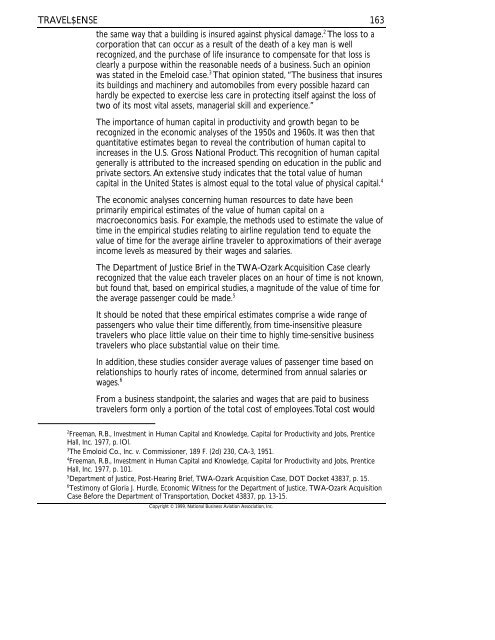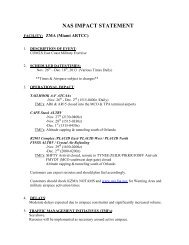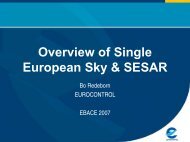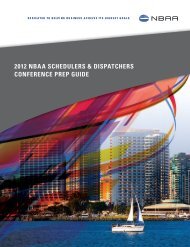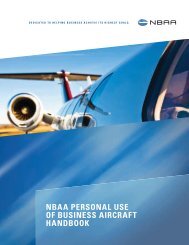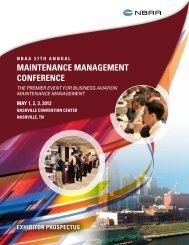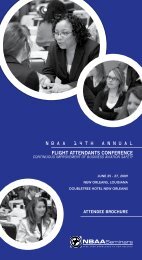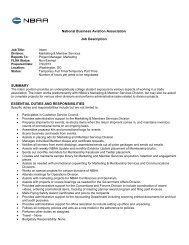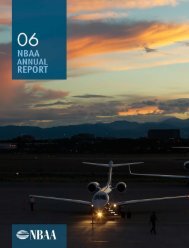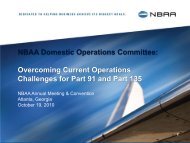162TRAVEL$ENSEIt generally is recognized that the value of an individual’s time is greater than hisor her salary alone. Fringe benefits, social security, furniture and otheraccommodations are but a few of the additional direct costs that must beborne by a company, in addition to the direct salary received by an individualemployee.There are other aspects of value received from individual employee effort,however, that go beyond direct salary moneys paid out – these aspects can beconsidered under the heading of human resource accounting.The field of human resource accounting, which recognizes people, their training,skills and experience as a human capital asset, is developing into a mature,recognized science. Human resource accounting is premised on the conclusionthat the human factor is vitally important to success in business. Many studieshave been conducted that indicate profits are to a large degree the result ofcontributions of management personnel, who possess the skills and experienceto direct the efficient use of material resources of business. Incompetentmanagement is the chief cause for business failure. 1Traditional accounting recognition of human resources has treated people onlyas a period cost, or expenditure, measured in terms of employeecompensation. There are no provisions under asset accounting for the humancapital values corporations employ. This, however, does not mean that humanresources have no value over and above employment costs. They havesubstantial values that merely are not recognized under traditional periodaccounting principles.Another example of a difference between a cost and an unrecognized valueunder traditional accounting concerns property. Property is normally carriedunder traditional accounting at book value, acquisition cost less applicableaccumulated depreciation. The market value of the property often isconsiderably more than the book value, but the true value will not berecognized until disposal of the property, when a gain is recorded. The onlytime some value of human resources may be recognized under traditionalaccounting is under the intangible asset account of “goodwill” in the sale of abusiness.Unlike with traditional accounting practices, human resource accounting placesa value on people, rather than a cost, thereby recognizing the importance ofhuman resource contributions to an organization. Such values have long beenrecognized and appraised in the insurance industry in the offering andunderwriting of key man insurance policies for businesses. A key man may bethought of as a valuable asset who is insured by his firm against possible loss in1 Smith, J.C., Key Man Protection, Life and Health Insurance Handbook, Richard D. Irwin, Inc., Homewood,Ill., 3rd Ed. 1973 p. 647.Copyright © 1999, National Business Aviation Association, Inc.
TRAVEL$ENSEthe same way that a building is insured against physical damage. 2 The loss to acorporation that can occur as a result of the death of a key man is wellrecognized, and the purchase of life insurance to compensate for that loss isclearly a purpose within the reasonable needs of a business. Such an opinionwas stated in the Emeloid case. 3 That opinion stated, “The business that insuresits buildings and machinery and automobiles from every possible hazard canhardly be expected to exercise less care in protecting itself against the loss oftwo of its most vital assets, managerial skill and experience.”163The importance of human capital in productivity and growth began to berecognized in the economic analyses of the 1950s and 1960s. It was then thatquantitative estimates began to reveal the contribution of human capital toincreases in the U.S. Gross National Product. This recognition of human capitalgenerally is attributed to the increased spending on education in the public andprivate sectors. An extensive study indicates that the total value of humancapital in the United States is almost equal to the total value of physical capital. 4The economic analyses concerning human resources to date have beenprimarily empirical estimates of the value of human capital on amacroeconomics basis. For example, the methods used to estimate the value oftime in the empirical studies relating to airline regulation tend to equate thevalue of time for the average airline traveler to approximations of their averageincome levels as measured by their wages and salaries.The Department of Justice Brief in the TWA-Ozark Acquisition Case clearlyrecognized that the value each traveler places on an hour of time is not known,but found that, based on empirical studies, a magnitude of the value of time forthe average passenger could be made. 5It should be noted that these empirical estimates comprise a wide range ofpassengers who value their time differently, from time-insensitive pleasuretravelers who place little value on their time to highly time-sensitive businesstravelers who place substantial value on their time.In addition, these studies consider average values of passenger time based onrelationships to hourly rates of income, determined from annual salaries orwages. 6From a business standpoint, the salaries and wages that are paid to businesstravelers form only a portion of the total cost of employees. Total cost would2 Freeman, R.B., Investment in Human Capital and Knowledge, Capital for Productivity and Jobs, PrenticeHall, Inc. 1977, p. lOl.3 The Emoloid Co., Inc. v. Commissioner, 189 F. (2d) 230, CA-3, 1951.4 Freeman, R.B., Investment in Human Capital and Knowledge, Capital for Productivity and Jobs, PrenticeHall, Inc. 1977, p. 101.5 Department of Justice, Post-Hearing Brief, TWA-Ozark Acquisition Case, DOT Docket 43837, p. 15.6 Testimony of Gloria J. Hurdle, Economic Witness for the Department of Justice, TWA-Ozark AcquisitionCase Before the Department of Transportation, Docket 43837, pp. 13-15.Copyright © 1999, National Business Aviation Association, Inc.
- Page 1 and 2:
TRAVEL$ENSEITRAVEL$ENSEBUSINESS TRA
- Page 3 and 4:
TRAVEL$ENSE3.1 Ownership. The compo
- Page 5 and 6:
TRAVEL$ENSETABLE OF CONTENTSCHAPTER
- Page 7 and 8:
TRAVEL$ENSECHAPTER 9. TAB 3 - TRAVE
- Page 9 and 10:
TRAVEL$ENSECHAPTER 1. INTRODUCTION1
- Page 11 and 12:
TRAVEL$ENSEBusiness aircraft are ut
- Page 13 and 14:
TRAVEL$ENSE• Certainty - A compan
- Page 15 and 16:
TRAVEL$ENSEThe catalyst for Travel$
- Page 17 and 18:
TRAVEL$ENSECHAPTER 2. NEW FEATURES
- Page 19 and 20:
TRAVEL$ENSEownership, charter aircr
- Page 21 and 22:
TRAVEL$ENSECHAPTER 3. INSTALLATION
- Page 23 and 24:
TRAVEL$ENSE15Upgrading from Release
- Page 25 and 26:
TRAVEL$ENSENow, you may then launch
- Page 27 and 28:
TRAVEL$ENSEconnection is not availa
- Page 29 and 30:
TRAVEL$ENSEat any time using the Co
- Page 31 and 32:
TRAVEL$ENSERegistering with the Air
- Page 33 and 34:
TRAVEL$ENSECHAPTER 4. DEFAULT SETTI
- Page 35 and 36:
TRAVEL$ENSEcost of aircraft selecte
- Page 37 and 38:
TRAVEL$ENSEMileage cost is calculat
- Page 39 and 40:
TRAVEL$ENSECHARGE CREW EXPENSES DEF
- Page 41 and 42:
TRAVEL$ENSELEG DEAD TIME33Leg Dead
- Page 43 and 44:
TRAVEL$ENSE35PERCENT PRODUCTIVITY D
- Page 45 and 46:
TRAVEL$ENSEIn 1997, an NBAA-commiss
- Page 47 and 48:
TRAVEL$ENSE3:00 p.m., you have defi
- Page 49 and 50:
TRAVEL$ENSE• Price the top ranked
- Page 51 and 52:
TRAVEL$ENSETIME VALUATION METHOD43A
- Page 53 and 54:
TRAVEL$ENSETo change a password, fi
- Page 55 and 56:
TRAVEL$ENSECHAPTER 5. PROFILES IN T
- Page 57 and 58:
TRAVEL$ENSEquickly, click on Alt-A
- Page 59 and 60:
TRAVEL$ENSEloads, prevailing winds
- Page 61 and 62:
TRAVEL$ENSEAirport ProfilesTo add a
- Page 63 and 64:
TRAVEL$ENSEBilling Code ProfilesBil
- Page 65 and 66:
TRAVEL$ENSEPassenger Profiles“Don
- Page 67 and 68:
TRAVEL$ENSE59To add a trip valuatio
- Page 69 and 70:
TRAVEL$ENSECHAPTER 6. CREATING TRIP
- Page 71 and 72:
TRAVEL$ENSE63Print a Report (Hotkey
- Page 73 and 74:
TRAVEL$ENSECHAPTER 7. TAB 1 - DEFIN
- Page 75 and 76:
TRAVEL$ENSEPurposeOutcomeHypothetic
- Page 77 and 78:
TRAVEL$ENSEThis field has a range o
- Page 79 and 80:
TRAVEL$ENSETo change multiple passe
- Page 81 and 82:
TRAVEL$ENSEbelow with the site visi
- Page 83 and 84:
TRAVEL$ENSEConsequently, users are
- Page 85 and 86:
TRAVEL$ENSEDRIVE TIMES77Finally, ch
- Page 87 and 88:
TRAVEL$ENSE79The upper table of the
- Page 89 and 90:
TRAVEL$ENSECHAPTER 8. TAB 2 - COMPA
- Page 91 and 92:
TRAVEL$ENSEof flights obtained so f
- Page 93 and 94:
TRAVEL$ENSEon Leg 1 and one passeng
- Page 95 and 96:
TRAVEL$ENSE87In addition to the typ
- Page 97 and 98:
TRAVEL$ENSE89You should try to run
- Page 99 and 100:
TRAVEL$ENSEselecting the leg and fl
- Page 101 and 102:
TRAVEL$ENSECHAPTER 9. TAB 3 - TRAVE
- Page 103 and 104:
TRAVEL$ENSETrip Expensescoming/goin
- Page 105 and 106:
TRAVEL$ENSECHAPTER 10. TAB 4 - COST
- Page 107 and 108:
TRAVEL$ENSEThis category also inclu
- Page 109 and 110:
TRAVEL$ENSE101If chronic, Non-Busin
- Page 111 and 112:
TRAVEL$ENSECHAPTER 11. TAB 5 - BENE
- Page 113 and 114:
TRAVEL$ENSETime Saved vis-à-vis Ai
- Page 115 and 116:
TRAVEL$ENSETrip StatisticsTravel$en
- Page 117 and 118:
TRAVEL$ENSECHAPTER 12. TRAVEL$ENSE
- Page 119 and 120: TRAVEL$ENSEThe Short Trip Report111
- Page 121 and 122: TRAVEL$ENSEclass. Fare detail also
- Page 123 and 124: TRAVEL$ENSESummary Reportslisted se
- Page 125 and 126: TRAVEL$ENSErepresentative of travel
- Page 127 and 128: TRAVEL$ENSEThe Business Aircraft Pe
- Page 129 and 130: TRAVEL$ENSEThe Trip Database Statis
- Page 131 and 132: TRAVEL$ENSE123CHAPTER 13. WORKING W
- Page 133 and 134: TRAVEL$ENSESelect any number of tri
- Page 135 and 136: TRAVEL$ENSECHAPTER 14. IMPORTING DA
- Page 137 and 138: TRAVEL$ENSE129Seven data fields are
- Page 139 and 140: TRAVEL$ENSE131Five data fields are
- Page 141 and 142: TRAVEL$ENSECHAPTER 15. THE IDEAS BE
- Page 143 and 144: TRAVEL$ENSEcan help maximize employ
- Page 145 and 146: TRAVEL$ENSE• At-airport “passen
- Page 147 and 148: TRAVEL$ENSEProductivity during driv
- Page 149 and 150: TRAVEL$ENSE• Long-distance trips
- Page 151 and 152: TRAVEL$ENSE143A major source of tim
- Page 153 and 154: TRAVEL$ENSEpersonnel of $65,000 ann
- Page 155 and 156: TRAVEL$ENSE• Clearing through sec
- Page 157 and 158: TRAVEL$ENSEOPTIMIZATION OF PLANT LO
- Page 159 and 160: TRAVEL$ENSE10. The quality control
- Page 161 and 162: TRAVEL$ENSEThe ability to work enro
- Page 163 and 164: TRAVEL$ENSEavailability of business
- Page 165 and 166: TRAVEL$ENSE3. Business aircraft off
- Page 167 and 168: TRAVEL$ENSEflight analysis in compa
- Page 169: TRAVEL$ENSESUMMATION OF FINANCIAL B
- Page 173 and 174: TRAVEL$ENSEappraisal of a given pro
- Page 175 and 176: TRAVEL$ENSE• provisional costs fo
- Page 177 and 178: TRAVEL$ENSEsecurity, medical insura
- Page 179 and 180: TRAVEL$ENSEkey manager’s salary.
- Page 181 and 182: TRAVEL$ENSE• The Group-Human Valu
- Page 183 and 184: TRAVEL$ENSEhours flown, miles flown
- Page 185 and 186: TRAVEL$ENSEALLOCATING AIRCRAFT OPER
- Page 187 and 188: TRAVEL$ENSEFlat mileage assessment
- Page 189 and 190: TRAVEL$ENSEIf you have a less-than-
- Page 191 and 192: TRAVEL$ENSEthose analyses, which th
- Page 193 and 194: TRAVEL$ENSE1852. Summary ReportsThe
- Page 195 and 196: TRAVEL$ENSEgetting on and off are p
- Page 197 and 198: TRAVEL$ENSEconsiderations, subseque
- Page 199 and 200: TRAVEL$ENSEcompletely current as of
- Page 201 and 202: TRAVEL$ENSE193Travel$ense did this
- Page 203 and 204: TRAVEL$ENSEstart of an after-hours
- Page 205 and 206: TRAVEL$ENSESleeping time is never v
- Page 207 and 208: TRAVEL$ENSEPRODUCTIVE HOURS199This
- Page 209 and 210: TRAVEL$ENSE201Copyright © 1999, Na
- Page 211 and 212: TRAVEL$ENSECrew Expenses · 31Crew
- Page 213 and 214: TRAVEL$ENSEPRC Aviation · 142Prima


